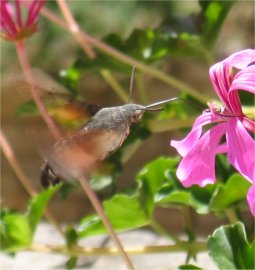Hawk moth
|
|
| Hawk moths | ||||||||||||
|---|---|---|---|---|---|---|---|---|---|---|---|---|
 Hummingbird hawk moth, Macroglossum stellatarum | ||||||||||||
| Scientific classification | ||||||||||||
Template:Taxobox section type species Template:Taxobox section diversity | ||||||||||||
| Subfamilies | ||||||||||||
Hawk moths or Sphinx moths are moths in the family Sphingidae. They are some of the fastest flying insects, capable of flying at over 50 km/h (30 miles per hour). They have a wingspan of 35-150 millimeters. Some hawk moths, like the hummingbird hawk moth, hover in midair while they feed on nectar from flowers and are sometimes mistaken for hummingbirds, even in continents where hummingbirds are not found.
Hawk moth larvae are often known as hornworms, because most have a "horn" at the posterior end. Large green tomato hornworms are a familiar sight to vegetable gardeners, usually noticed only after they have defoliated large amount of tomato leaves. Tobacco hornworms (Manduca sexta) feed on tobacco leaves.
Hawk moths have a very specialized proboscis that can be up to 30 cm in length. This proboscis allows it to eat from Comet Orchids, a rare flower with its nectar stored at the bottom of a 30 cm long tube, which is accessible to no other bird or pollinating insect. The Comet Orchid was first discovered by Darwin, and he famously predicted that there must be some specialised animal to feed from it, and while he was ridiculed, he was proved correct 21 years later.
Some species
- Death's-head Hawkmoth (Acherontia atropos)
- Lime Hawk-moth (Mimas tiliae)
- Poplar Hawk-moth (Laothoe populi)
- Catalpa Sphinx (Ceratomia catalpae)
- Hummingbird hawk moth (Macroglossum stellatarum)
- Elephant hawk moth (Deilephila elpenor)

